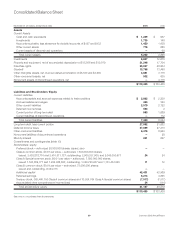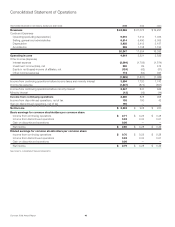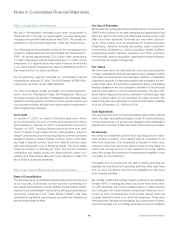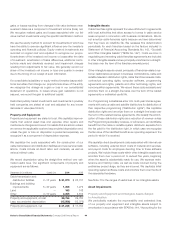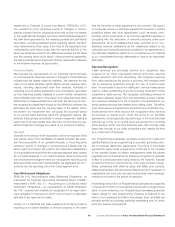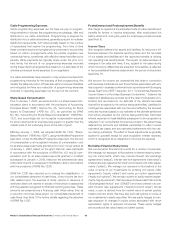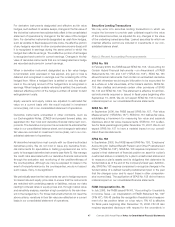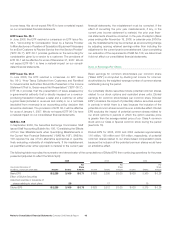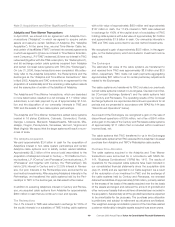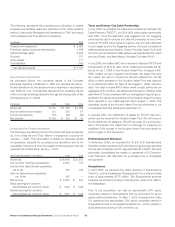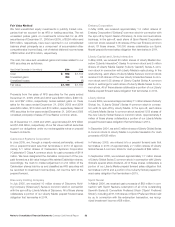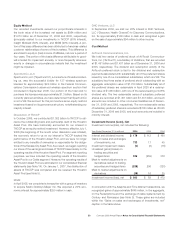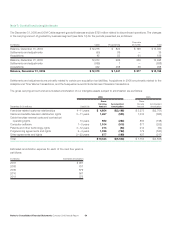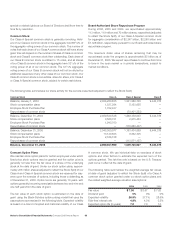Comcast 2006 Annual Report Download - page 50
Download and view the complete annual report
Please find page 50 of the 2006 Comcast annual report below. You can navigate through the pages in the report by either clicking on the pages listed below, or by using the keyword search tool below to find specific information within the annual report.
Notes to Consolidated Financial Statements Comcast 2006 Annual Report 48
income taxes. We do not expect FIN 48 to have a material impact
on our consolidated financial statements.
EITF Issue No. 06-1
In June 2006, the EITF reached a consensus on EITF Issue No.
06-1, “Accounting for Consideration Given by a Service Provider
to Manufacturers or Resellers of Specialized Equipment Necessary
for an End-Customer to Receive Service from the Service Provider”
(“EITF 06-1”). EITF 06-1 provides guidance on the accounting for
consideration given by a vendor to a customer. The provisions of
EITF 06-1 will be effective for us as of December 31, 2007. We do
not expect EITF 06-1 to have a material impact on our consoli-
dated financial statements.
EITF Issue No. 06-3
In June 2006, the EITF reached a consensus on EITF Issue
No. 06-3, “How Taxes Collected from Customers and Remitted
to Governmental Authorities Should Be Presented in the Income
Statement (That Is, Gross versus Net Presentation)” (“EITF 06-3”).
EITF 06-3 provides that the presentation of taxes assessed by
a governmental authority that is directly imposed on a revenue-
producing transaction between a seller and a customer on either
a gross basis (included in revenues and costs) or on a net basis
(excluded from revenues) is an accounting policy decision that
should be disclosed. The provisions of EITF 06-3 will be effective
for us as of January 1, 2007. We do not expect EITF 06-3 to have
a material impact on our consolidated financial statements.
SAB No. 108
In September 2006, the Securities Exchange Commission Staff
issued Staff Accounting Bulletin No. 108, “Considering the Effects
of Prior Year Misstatements when Quantifying Misstatements in
the Current Year Financial Statements” (“SAB No. 108”). SAB No.
108 requires the use of two alternative approaches in quantita-
tively evaluating materiality of misstatements. If the misstatement
as quantified under either approach is material to the current year
financial statements, the misstatement must be corrected. If the
effect of correcting the prior year misstatements, if any, in the
current year income statement is material, the prior year finan-
cial statements should be corrected. In the year of adoption (fiscal
years ending after November 15, 2006, or calendar year 2006 for
us), the misstatements may be corrected as an accounting change
by adjusting opening retained earnings rather than including the
adjustment in the current year income statement. Upon completing
our evaluation of the requirements of SAB No. 108, we determined
it did not affect our consolidated financial statements.
Note 4: Earnings Per Share
Basic earnings for common stockholders per common share
(“Basic EPS”) is computed by dividing net income for common
stockholders by the weighted-average number of common shares
outstanding during the period.
Our potentially dilutive securities include potential common shares
related to our stock options and restricted share units. Diluted
earnings for common stockholders per common share (“Diluted
EPS”) considers the impact of potentially dilutive securities except
in periods in which there is a loss because the inclusion of the
potential common shares would have an antidilutive effect. Diluted
EPS excludes the impact of potential common shares related to
our stock options in periods in which the option exercise price
is greater than the average market price of our Class A common
stock and our Class A Special common stock during the period
(see Note 10).
Diluted EPS for 2006, 2005 and 2004 excludes approximately
116 million, 126 million and 154 million, respectively, of potential
common shares related to our share-based compensation plans
because the inclusion of the potential common shares would have
an antidilutive effect.
The following table reconciles the numerator and denominator of the computations of Diluted EPS from continuing operations for the years
presented (adjusted to reflect the Stock Split):
2006 2005 2004
Per Per Per
Year Ended December 31 Share Share Share
(in millions, except per share data) Income Shares Amount Income Shares Amount Income Shares Amount
Basic EPS $ 2,235 3,160 $ 0.71 $ 828 3,295 $ 0.25 $ 928 3,360 $ 0.28
Effect of Dilutive Securities
Assumed exercise or issuance of
shares relating to stock plans 20 17 15
Diluted EPS $ 2,235 3,180 $ 0.70 $ 828 3,312 $ 0.25 $ 928 3,375 $ 0.28



